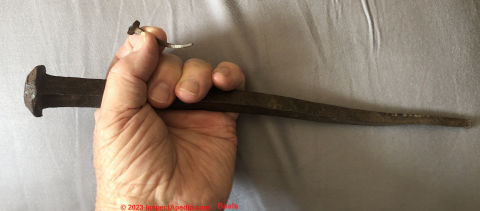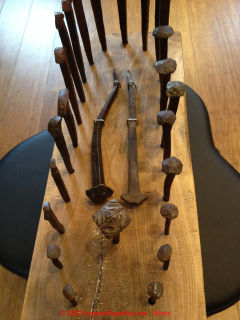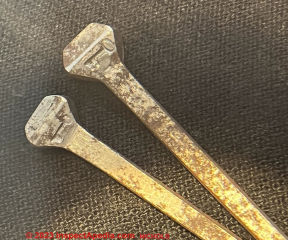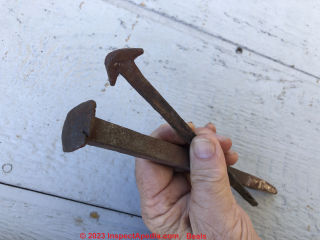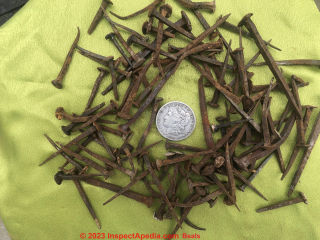 Nails Used in Early Barter or Trade
Nails Used in Early Barter or Trade
History, research, debate
- POST a QUESTION or COMMENT about early traders or sailors who used nails in bartering for goods or services
This article discusses and questions the use of nails in early barter or perhaps informal trade between European sailors and later traders and people in parts of the world where iron was scarce or nail production nonexistent.
Page top photo: antique hand wrought nails from Spain, courtesy of G. Beals, cited below.
InspectAPedia tolerates no conflicts of interest. We have no relationship with advertisers, products, or services discussed at this website.
- Daniel Friedman, Publisher/Editor/Author - See WHO ARE WE?
Nails in Early Trade & Barter
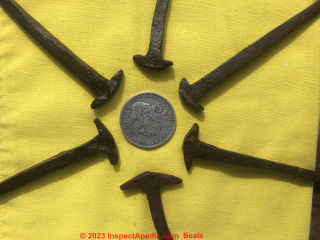 At our home page for this topic, NAILS, AGE & HISTORY - home, we included an introduction to the history of nails used as trade or barter items, particularly by European sailors arriving in the South Pacific and possibly in other areas where iron was scarce.
At our home page for this topic, NAILS, AGE & HISTORY - home, we included an introduction to the history of nails used as trade or barter items, particularly by European sailors arriving in the South Pacific and possibly in other areas where iron was scarce.
Here we expand that brief discussion of the history of early trading or barter involving nails, benefiting from a healthy debate from reader Gary Beals, a California reader who has expressed skepticism over the claim of sailors bartering with nails or using them as "currency" - perhaps a bit of a more formal suggestion than our sources claim.
Photo: hand forged nails found in Spain, courtesy of Beals.
[Click to enlarge any image]
The photographs shown here of antique, hand-forged nails found in Spain illustrate nails that may be several hundred years old, and are provided courtesy of Mr. Gary Beals, identified in the discussion below as G.B. who can be contacted at segovia.gary@yahoo.com
1766 - Iron Nails Used as Barter
Although traditional Tahitian culture did not sanction extramarital sexual relations, within 48 hours of Wallis's arrival, Tahitian husbands and fathers were encouraging their wives and daughters to swim out to the Dolphin and offer the sailors sex in exchange for iron nails.
Aware of the brisk trade in iron, later explorers such as Captain James Cook brought supplies of nails and hoop iron with them to barter for fresh water, fish, pork, and vegetables. (Denver, 2013 Tahiti, p. 682-683)
G.B.: Examples of antique Spanish hand-forged nails - as barter? Urban Legend!
I would like to send you some sample nails from Spain which are from 150 to 400 years old. I did not hear back from anyone.
I continue to work on an article in the numismatic field on the urban legend that nails were used as money in colonial America. No documentation older than the 1920s supports this tale.
One of the details I would like to better understand is the different types of hand forged nails. The most common are nails with a gable head – or guardia civil hat as we would have said in Spain.
Photo above by G.B. who asks: I wonder why this shape nail head was far more common in Spain for centuries than a round top -- as above.
Less common are round headed nails and spikes, the most nail-like in the modern mind. Basically this nail went without change for more than 2,000 years.
Can you connect me with anyone interested in nails of 300 years ago? - G.B. 2023/10/23
Moderator reply (DF): examine nail details such as head, tip, shank for function, decorative detail, and tool marks
Your nail photo and those nail heads are particularly interesting. I speculate that often the design of a nail head went well beyond its intended use and to decorative function.
We certainly saw that in clinched nails in doors in both Spain and Mexico. And you might simply come across a collection of nails made by one or a few local blacksmiths who had their particular signature style. I've a long abiding interest in old nails and have looked at some old construction in Spain, esp. in Barcelona and in the countryside. But I'm not a PhD nail expert.
About the most I might do with antique nails is look at them under various magnifications and microscopically for detailed visual clues such as cracks or fissures. Honestly not worthwhile in this case. Our nail history articles and photos at InspectApedia outline their long history and there you'll see that size, probably more than head shape, determined the range of uses; earliest were tacks.
Tremont's nail library that we have reproduced online may also be of some use to you. There are some basic observations we can make on your nails such as the straight shanks that suggest hand forging before nails were being cut from blanks, but nail uses are very broad, mostly a function of size, with some specialized heads just for narrow applications such as fencing (hooked heads) or to permit easy withdrawal (double heads).
We could order metallurgical scans and chemistry but in my opinion that's not likely to be cost-reasonable. About using nails as money, I, too, have read that nails were so precious in some parts of the world (such as the South Pacific) that they were not only traded for other goods, but ship captains had to be very tough on sailors who otherwise would pull nails out of the ship's hull to trade for other goods that they put the ship in danger. We've probably both read those anecdotal accounts.
I'm posting your photos and discussion on this page, but you'll also want to review the nail history and age-dating procedures given at the Continue Reading and Recommended Articles found at the end of this page.
Reader follow-up G.B.: don't believe anyone used nails as an established and regulated barter
Thanks for your feedback on blacksmith-made nails. I never saw a factory-made cut nail in Spain in 20-some years of looking at iron objects and collecting them. All were hand made, drawned out by hammering in a Smithy.
Your story about nails used in barter in the South Pacific was new to me. How any swabbie could remove an iron spike from a ship's beam or hull is beyond me. For the record: I don't believe anyone used nails as an established and regulated barter form because there were too many sizes and at least two heads.
I am still trying to find out what the different heads were for. Gable-head vs round head. The story is confused by the useful value of nails creating desire for acquiring them While I have decorative nails made by skilled blacksmiths they do not have a role in the nails and money article.
Again: I can send you or anyone interested some sample nails. You said: We certainly saw that in clinched nails in doors in both Spain and Mexico.
What does clinched mean? G.B. 2024/01/24
Photo below: a display I made for the Segivia Mint in Spain.
Why the different nail heads?
Moderator reply (DF): standard nail sized such as 6d - gave size, and quantity that could be purchased for a given sum.
From early on efforts were made to define standard nail sizes, weights, uses, which is how the terms "penny" or abbreviation "d" such as 6d nails, signifying six-penny nails that gave not only the nail size but would indicate how many such nails could be purchased for a British penny. There are ample historical works on this topic, some of which we cite
at NAIL & HARDWARE, AGE RESEARCH
But I agree that typical historical documents that we've read on using nails in early barter and trade describe an informal bartering system that would be less well defined or standardized than the use of early coins.
"Clinched" refers to the practice of bending over the tip of a nail that protruded through wood or other material through which it was driven.
So a hammered through a door and clinched over nail is almost impossible to remove from the exterior side - making the door or structure stronger.
In horse shoeing, the nail tip protrudes up through the side of the hoof, its tip nipped off, and the rest of the protruding end clinched over, again to prevent loss of the shoe.
Above: a modern horseshoe nail with its distinctive flattened head.
Different nail heads served different purposes, both functional and decorative, such as finishing nails whose head was to be sunken into wood, large headed nails that were meant to secure material in place against a surface, double headed nails to be used temporarily then withdrawn, horseshoe nails whose heads fit into a groove in the shoe, etc. - far more variations and uses than fit here in a discussion of nails used in barter.
About bartering with nails, it's a common thread throughout reports of early sailing in the South Pacific - we don't invent material at InspectApedia. But you use the word "organized" and I'd agree that it's doubtful that there was any organized or standardized nail-barter standard. Iron was scarce and nails were probably used to form tools or weapons.
Reader follow-up G.B. - "Cast Nails" ?
Key point is that the numismatic focus on nails is still in draft – lots of details but trying to get everything tied together. And clinched nails -- My new house door will have 18 artistic spikes and plaques that are about 400 years old from Spain.
The spikes were driven through a two-inch thick door, bent anmd bent again to drive the tip into the back of the door. I bought these from a junk yard 50 years ago – hard to find such items today in Spain.
And clinched nails -- My new house door will have 18 artistic spikes and plaques that are about 400 years old from Spain.
The spikes were driven through a two-inch thick door, bent anmd bent again to drive the tip into the back of the door. I bought these from a junk yard 50 years ago – hand to find such items today in Spain.
The term 'cast nails' pops up in my research -- I think that is because to many historians don't understand the techologies -- Cast nails would be brittle and unusable a second time I am sure.
Below: two basic nail head types I found in Spain. How are different types used?
Research: Iron Nails in Barter Economies
- Cavanagh, Ted. "Balloon houses: The original aspects of conventional wood-frame construction re-examined." Journal of Architectural Education 51, no. 1 (1997): 5-15.
Excerpt:
As the Midwest was a barter economy based on wood, nails were ... - Goldberg, Walter M., and Walter M. Goldberg. "Import, Barter and Trade, and the Natural Resources of the Pacific Islands." The Geography, Nature and History of the Tropical Pacific and its Islands (2018): 77-110. Rickard, Thomas Arthur. "The knowledge and use of iron among the South Sea islanders." The Journal of the Royal Anthropological Institute of Great Britain and Ireland 62 (1932): 1-22.
- Lane, Lizzie. Home Sweet Home:(Sweet Sisters# 3). Random House, 2015.
Excerpt:
Iron nails provided currency, a poor currency maybe,...
- Sahlins, Marshall. "The economics of develop-man in the Pacific." Res: Anthropology and Aesthetics 21, no. 1 (1992): 12-25.
- Sheriff, Mary. "Nails, Necklaces and Curiosities: Scenes of Exchange in Bougainville's Tahiti." Art history 38, no. 4 (2015): 792-805. - retrieved 2024/01/25, original source: academic.oup.com/arthistory/article/38/4/792/7278264 - Local copy on file as Nails-History-Sheriff.pdf
Excerpts:
The voyage accounts, both published and unpublished, also record what the French left behind in Tahiti, including trifles such as handkerchiefs and hats, as well as more useful goods such as iron nails and tools. Not simply enumerating objects bartered, stolen, or given as gifts, French accounts also picture the passions these objects provoked, and prime among them were curiosity, envy, avarice and desire.
Tableaux of Barter:
Nails as Objects of Exchange Anthropologist Nicholas Thomas has argued that traditional anthropology narrativizes barter as the story of a gap between primitive tools and the manufactured things of white men. In this story, the magic of European products is the source of asymmetry between ‘powerless natives and dominant European colonizers’.4
Natives are seen as desperate to obtain European things, even if they are of neither use nor intrinsic value, and eventually the natives lose both their autonomy and culture in striving for such goods.
Through case studies Thomas shows that this narrative of barter, which poses the natives as both powerless and foolhardy, is neither accurate nor able to explain specific instances of trade. He points out, for example, that the Marquesans refused to exchange their pigs, which they placed above all price, for the iron implements that natives throughout the Pacific eagerly sought.
Iron nails, in particular, stimulated a lively trade with European visitors, and in this bartering natives were hardly powerless.5
Nails took on significance in Tahiti that they never had in Europe, although both cultures valued them for their utility. The production of nails depended on advanced technologies of metallurgy, more specifically, of extracting ore, smelting it, and forging the iron.
The lowly nail and its production entered the Encyclopédie in an article authored by Diderot under the rubric Art méchanique, and plates illustrated the processes and products of manufacture.
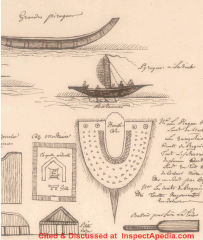
The image of nail making (plate 1) is formulaic: a small vignette at the top represents the process of manufacturing, whose products are arrayed in a larger space below.
Although at first glance the process and products seem relatively simple, their complexity emerges as the three steps in making nails: heating the iron, forming the body, and attaching shaft to head are complicated by the range of essential tools illustrated in the image and identified in a key.
The many types of nails depicted below the vignette are ordered and named so as to create a highly diversifi ed set of simple tools designed for specific tasks.
Iron nails and fittings were essential to shipbuilding, and they travelled to Tahiti both inadvertently as part of a vessel and intentionally as part of the equipment to repair ships and perform other types of construction. - Smith, Adam. "Barter and Money." In Précis Writing, pp. 98-101. Routledge, 2015.
- Weeks, John H. "Notes On Barter And Keeping A Barter Store." International Review Of Mission 6, No. 2 (1917): 233-243.
Excerpt:
Every article of barter goods in our store had a price on it that the natives understood ... take cottons, spoons, knives, brass chair nails up to the agreed number of strings of beads ... - See also: NAIL & HARDWARE, AGE RESEARCH
...
Continue reading at NAIL & HARDWARE, AGE RESEARCH, or select a topic from the closely-related articles below, or see the complete ARTICLE INDEX.
Or see these
Recommended Articles
- AGE of a BUILDING, HOW to DETERMINE - home
- DOOR HARDWARE AGE
- NAILS, AGE & HISTORY - home
- HORSESHOE & HORSESHOE NAIL AGE
- NAIL & HARDWARE, AGE RESEARCH
- NAIL & HARDWARE CLEAN-UP
- NAIL AGE DETERMINATION KEY - use this key to guess at the age of your nail or spike
- NAIL ID & AGE: CUT NAILS
- NAIL ID & AGE: HAND FORGED NAILS
- NAILS in BARTER & TRADE
- NAIL SPLITS & CRACKS vs AGE
- NAIL TYPE, ANTIQUE, IDENTIFICATION KEY
- RAILROAD SPIKES
- RAILROAD SPIKE AGE - CONTEXTUAL CLUES
- SAW & AXE CUTS, TOOL MARKS, AGE
- WINDOW HARDWARE AGE
Suggested citation for this web page
NAILS in BARTER & TRADE at InspectApedia.com - online encyclopedia of building & environmental inspection, testing, diagnosis, repair, & problem prevention advice.
Or see this
INDEX to RELATED ARTICLES: ARTICLE INDEX to BUILDING AGE
Or use the SEARCH BOX found below to Ask a Question or Search InspectApedia
Ask a Question or Search InspectApedia
Try the search box just below, or if you prefer, post a question or comment in the Comments box below and we will respond promptly.
Search the InspectApedia website
Note: appearance of your Comment below may be delayed: if your comment contains an image, photograph, web link, or text that looks to the software as if it might be a web link, your posting will appear after it has been approved by a moderator. Apologies for the delay.
Only one image can be added per comment but you can post as many comments, and therefore images, as you like.
You will not receive a notification when a response to your question has been posted.
Please bookmark this page to make it easy for you to check back for our response.
IF above you see "Comment Form is loading comments..." then COMMENT BOX - countable.ca / bawkbox.com IS NOT WORKING.
In any case you are welcome to send an email directly to us at InspectApedia.com at editor@inspectApedia.com
We'll reply to you directly. Please help us help you by noting, in your email, the URL of the InspectApedia page where you wanted to comment.
Citations & References
In addition to any citations in the article above, a full list is available on request.
- In addition to citations & references found in this article, see the research citations given at the end of the related articles found at our suggested
CONTINUE READING or RECOMMENDED ARTICLES.
- Carson, Dunlop & Associates Ltd., 120 Carlton Street Suite 407, Toronto ON M5A 4K2. Tel: (416) 964-9415 1-800-268-7070 Email: info@carsondunlop.com. Alan Carson is a past president of ASHI, the American Society of Home Inspectors.
Thanks to Alan Carson and Bob Dunlop, for permission for InspectAPedia to use text excerpts from The HOME REFERENCE BOOK - the Encyclopedia of Homes and to use illustrations from The ILLUSTRATED HOME .
Carson Dunlop Associates provides extensive home inspection education and report writing material. In gratitude we provide links to tsome Carson Dunlop Associates products and services.


